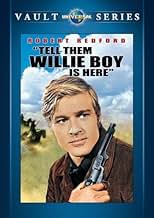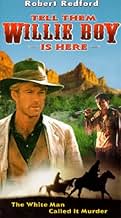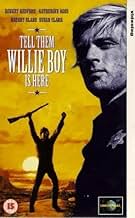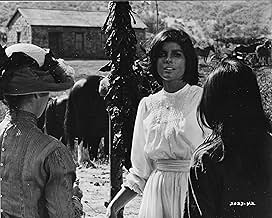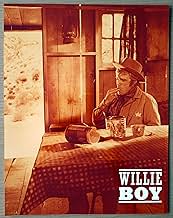NOTE IMDb
6,3/10
3,4 k
MA NOTE
En 1909, lorsque le jeune membre de la Première Nation Paiute Willie Boy retourne dans sa réserve californienne pour être avec Lola.En 1909, lorsque le jeune membre de la Première Nation Paiute Willie Boy retourne dans sa réserve californienne pour être avec Lola.En 1909, lorsque le jeune membre de la Première Nation Paiute Willie Boy retourne dans sa réserve californienne pour être avec Lola.
- Victoire aux 2 BAFTA Awards
- 3 victoires et 1 nomination au total
Erik Holland
- Digger
- (as Eric Holland)
Lee de Broux
- Meathead
- (as Lee De Broux)
Histoire
Le saviez-vous
- AnecdotesAbraham Polonsky said to a USC film class at the time that he purposely shot and edited the manhunt sequences with characters moving in all directions across the screen, rather than in the usual way wherein both runners and pursuers would move in the same direction across the shots (i.e., left to right) to enhance the impression of urgent suspense in a chase. Instead, Polonsky was looking for a different feel for the audience, of the characters wandering, feeling their way through the landscape. He implied he was willing to sacrifice some suspense to externalize the characters' confusion. He also said that for Katharine Ross' brief, artfully lit nude shot, he exposed the film correctly but then produced a high-contrast copy of the same film frames with deep blacks and transparent lights, then bi-packed both pieces of films together to rephotograph. The high-contrast overlay ensured that the shadows on Ross' body were black--so that the image could not reveal more in the shadows than it was supposed to.
- GaffesMany of the hats worn in the film are not the style worn during the early part of the 20th century. Some in fact, could only have been sewn using machines created in the 1950s, nearly half a century after the film's setting.
- Citations
Dr. Elizabeth Arnold: Willie killed Mike and took Lola. They call it marriage by capture. The mother knew that and told her to go.
- ConnexionsFeatured in Red Hollywood (1996)
Commentaire à la une
In 1909, an Indian youth and his girl flee a posse pursuing him for killing the girl's father. (Based loosely on a true story).
In 1969, the movie was received as part of the broader counter-cultural movement then flourishing. Certainly several of the film's themes resonated with the social justice wing of the movement, and I'm sure that for leftist writer-director Polonsky the justice-for-the-Indian theme was no stretch.
Seeing the film again after 40-years, I'm struck by how generally low-key it is, despite the highly charged potential. That's particularly the case with the lovers-on-the-run (Blake & Ross). Unlike such fugitive classics as You Only Live Once (1937) or They Live By Night (1947), this version refuses to sentimentalize the lovers. Despite standard expectations, Willie treats Lola pretty harshly and all but drags her along by the hair—a far cry from the usual pathos. Nor, for that matter, is the Coop (Redford)-Elizabeth (Clark) relationship romanticized, as she treats him with general disdain while he sexually humiliates her. (I doubt this film did anything for Redford's lover-boy image.)
At the same time, none of the principals is particularly likable, certainly a departure from usual box-office appeal. Coop may sympathize somewhat with Willie Boy, but he's clearly no reformer let alone racial crusader. He is, after all, an elected sheriff with a race conscious constituency, so his reserve is at least understandable. And, for that matter, neither is Willie Boy very likable. He may be a victim in an extended sense, yet he encourages little sympathy in his headlong flight for survival. If he's meant to represent Indian plight generally, it's certainly not an emotionalized appeal. In fact, the social justice element occurs only sporadically and through biting references to Indians' lesser worth as Indians. So, by no means, is the movie's message "piled on". Note too, how Polonsky refuses to caricature the one vicious racist, Calvert (Sullivan), in the manner of many other anti-racist films.
All in all, the movie comes across as something of an oddity since it follows no particular path other than its own. Clearly, Polonsky wants to avoid the more obvious pitfalls of movies with a message, and largely succeeds, at least in my estimation. However, the caution does come at something of a price. In short, so much of the material is low-keyed that I, for one, was never drawn emotionally into the dramatic events; instead I observed them at a distance, even Willie Boy's last stand, which should have been more of a grabber. Such detachment seems rather paradoxical for a film that should have strong impact given the themes and talent involved. My guess is that Polonsky used perhaps too much caution in dealing with what is admittedly tricky subject matter.
Nonetheless, it remains an interesting film, well acted and beautifully photographed, making good use of the barren edge of California's Mojave desert. I guess my only real gripe is with whoever did Ross's Indian make-up. As another reviewer aptly observes—it looks like it was slathered on with a ladle. Then there's the long lacquered hair that threatens at times to reach around and strangle her. Those minor misfires aside, Polonsky's project remains a curious one-of-a-kind, still worth a look-see, even if it's no longer the rebellious 1960's.
In 1969, the movie was received as part of the broader counter-cultural movement then flourishing. Certainly several of the film's themes resonated with the social justice wing of the movement, and I'm sure that for leftist writer-director Polonsky the justice-for-the-Indian theme was no stretch.
Seeing the film again after 40-years, I'm struck by how generally low-key it is, despite the highly charged potential. That's particularly the case with the lovers-on-the-run (Blake & Ross). Unlike such fugitive classics as You Only Live Once (1937) or They Live By Night (1947), this version refuses to sentimentalize the lovers. Despite standard expectations, Willie treats Lola pretty harshly and all but drags her along by the hair—a far cry from the usual pathos. Nor, for that matter, is the Coop (Redford)-Elizabeth (Clark) relationship romanticized, as she treats him with general disdain while he sexually humiliates her. (I doubt this film did anything for Redford's lover-boy image.)
At the same time, none of the principals is particularly likable, certainly a departure from usual box-office appeal. Coop may sympathize somewhat with Willie Boy, but he's clearly no reformer let alone racial crusader. He is, after all, an elected sheriff with a race conscious constituency, so his reserve is at least understandable. And, for that matter, neither is Willie Boy very likable. He may be a victim in an extended sense, yet he encourages little sympathy in his headlong flight for survival. If he's meant to represent Indian plight generally, it's certainly not an emotionalized appeal. In fact, the social justice element occurs only sporadically and through biting references to Indians' lesser worth as Indians. So, by no means, is the movie's message "piled on". Note too, how Polonsky refuses to caricature the one vicious racist, Calvert (Sullivan), in the manner of many other anti-racist films.
All in all, the movie comes across as something of an oddity since it follows no particular path other than its own. Clearly, Polonsky wants to avoid the more obvious pitfalls of movies with a message, and largely succeeds, at least in my estimation. However, the caution does come at something of a price. In short, so much of the material is low-keyed that I, for one, was never drawn emotionally into the dramatic events; instead I observed them at a distance, even Willie Boy's last stand, which should have been more of a grabber. Such detachment seems rather paradoxical for a film that should have strong impact given the themes and talent involved. My guess is that Polonsky used perhaps too much caution in dealing with what is admittedly tricky subject matter.
Nonetheless, it remains an interesting film, well acted and beautifully photographed, making good use of the barren edge of California's Mojave desert. I guess my only real gripe is with whoever did Ross's Indian make-up. As another reviewer aptly observes—it looks like it was slathered on with a ladle. Then there's the long lacquered hair that threatens at times to reach around and strangle her. Those minor misfires aside, Polonsky's project remains a curious one-of-a-kind, still worth a look-see, even if it's no longer the rebellious 1960's.
- dougdoepke
- 10 août 2012
- Permalien
Meilleurs choix
Connectez-vous pour évaluer et suivre la liste de favoris afin de recevoir des recommandations personnalisées
- How long is Tell Them Willie Boy Is Here?Alimenté par Alexa
Détails
- Date de sortie
- Pays d’origine
- Langue
- Aussi connu sous le nom de
- Tell Them Willie Boy Is Here
- Lieux de tournage
- Pioneertown, Californie, États-Unis(shoot out near end, Pipes Canyon)
- Société de production
- Voir plus de crédits d'entreprise sur IMDbPro
Box-office
- Montant brut mondial
- 5 949 $US
- Durée1 heure 38 minutes
- Couleur
- Rapport de forme
- 2.39 : 1
Contribuer à cette page
Suggérer une modification ou ajouter du contenu manquant

Lacune principale
By what name was Willie Boy (1969) officially released in India in English?
Répondre

